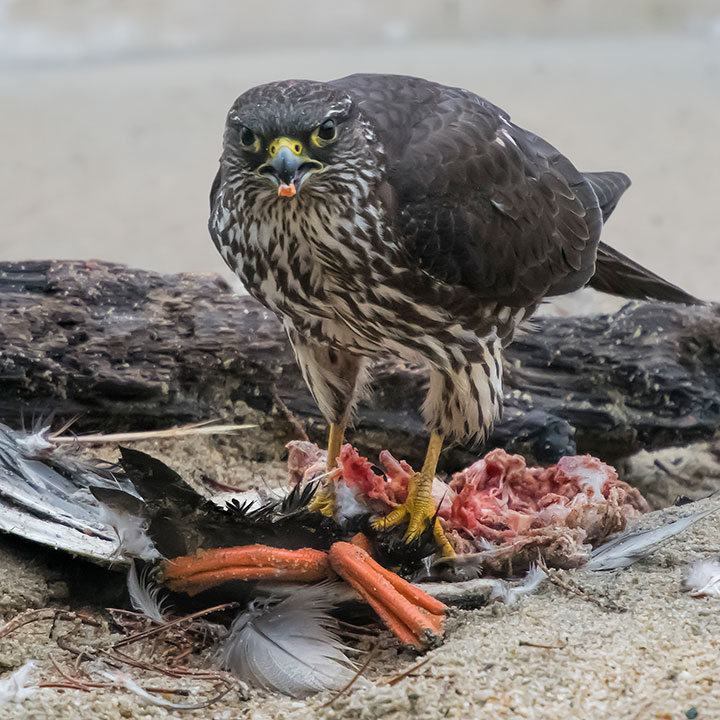Birds do not chew their food.
Indeed, only a few birds (mainly raptors) can even tear their food into smaller chunks before swallowing it. Certainly, a few birds will pick at fruit on a tree and gulls will pick at dead fish on a beach. However, most birds just swallow whole whatever they eat. This places constraints on the size of things most birds can eat. A kingfisher does not even bother looking for a fish that a heron would happily swallow.
I reflected on this when last week I was watching two birds feeding: a Snow Bunting that was picking off grass seeds and swallowing them; a Hooded Merganser that had caught and swallowed a small fish. These are the final two pictures. The first five pictures are older and are chosen to illustrate the issue.
A raptor can grip its prey and tear it apart with its hooked bill. This allows it to eat prey much larger than it could swallow whole. This is a Merlin feasting on a Mallard (2017 April 13).

Most birds swallow their prey whole and this constrains what they can eat. A robin can easily swallow a worm or moth (2016 May 19).

Dippers mainly swallow insects and fish eggs. A fry is perhaps the largest fish it can swallow whole (2012 Dec. 10).

This is a large fish for a Common Merganser to swallow whole (2016 August 30).

However, the merganser would not have been able to handle the rather large Kokanee being swallowed by this Great Blue Heron (2015 August 25).

A Snow Bunting picked off grass seeds and then swallowed each whole.

A Hooded Mergansers dived and then surfaced with a small fish. The event was interesting not just because the fish was swallowed whole. Unexpectedly, the catch is a member of the sunfish family, a black crappie or a pumpkinseed, both of which are native to eastern North America. They seem to have turned up in Kootenay Lake only within the last decade and neither is to be welcomed. Unfortunately, sunfish prey on small indigenous fish and have the potential to alter the local aquatic food chain. The only thing we have in our favour is that the coolness of the Lake may prevent them from becoming a nuisance.


Thanks for these fabulous photos and the educational information!
Thanks, Alistair such informative photographic illustrations!
Thanks for sharing all this interesting informations and selecting photos to explain your observations. Fascinating!
Thank you Alistair, for the wonderful photos & also the information with them. I was shocked to see the size of the fish the GBH was eating. Thank gosh for the Mergansers, maybe they will clean out the unwanted fish from Kootenay Lake with their quickness in swimming after such creatures.
As an easterner who has occasionally caught a fish, that is almost certainly not a pumpkinseed sunfish; pumpkinseeds have a blue “ear” on their gill covers that has an orange spot. The fish in the beak surely looks like a crappie. My condolences for having those exotics in the lake — exotics are the bane of all natural ecosystems.